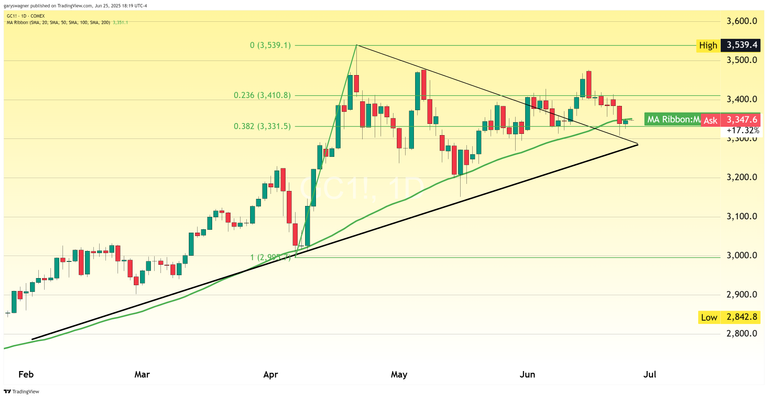(Kitco Commentary) - Gold markets demonstrated resilience on Wednesday, with the precious metal maintaining steady performance despite a significant shift in investor sentiment away from geopolitical risk considerations toward Federal Reserve monetary policy expectations.
The August gold futures contract closed at $2,347.00, posting modest gains of $8.60 as of 4:30 PM ET, while the US Dollar Index declined 0.23% to 97.74. Benchmark US equity indices finished the session with mixed results, reflecting the market's cautious positioning ahead of key policy developments.

The stabilization of the Israel-Iran ceasefire has fundamentally altered gold's risk profile, with safe-haven demand subsiding as both nations maintained their commitment to the agreement despite last-minute hostilities that extended nearly to the ceasefire deadline. This dramatic reduction in geopolitical tension typically would have pressured gold prices lower, yet the metal's performance exceeded the concurrent dollar weakness, indicating active accumulation by institutional and retail investors alike.
The divergence between reduced safe-haven demand and continued buying interest underscores a critical shift in market dynamics. Rather than relying solely on crisis-driven demand, gold traders are increasingly positioning for monetary policy changes, demonstrating the market's evolution toward more sophisticated risk assessment and strategic allocation decisions.
Market participants have redirected their focus toward Federal Reserve Chair Jerome Powell's congressional testimony, with his second day of appearances before the Senate Banking Committee drawing particular attention following his initial House Financial Services Committee session. The testimony has crystallized investor expectations around potential rate adjustments, with traders now assigning a 24.8% probability to a rate cut at the Fed's July meeting, according to the CME’s FedWatch tool.
Powell's measured approach to monetary policy has created a complex investment landscape. His emphasis on evaluating the comprehensive economic impact of proposed tariff policies before implementing additional rate cuts has generated notable tension with the Trump administration's preference for more aggressive easing measures. This political dynamic has added an additional layer of uncertainty to policy expectations, with Republican senators, including Ohio's Senator Moreno, challenging the Fed's analytical framework as potentially politically motivated.
The Federal Reserve Chair's acknowledgment that expanded tariff implementation would likely drive consumer prices higher while constraining economic activity has introduced new variables into the monetary policy equation. Powell's assessment that such inflationary pressures might prove temporary, depending on the final scope of tariff measures, has left investors parsing each statement for policy direction signals.
This nuanced position reflects the central bank's commitment to data-driven decision-making amid unprecedented political pressure. Powell's reaffirmation of the Fed's dual mandate of maximum employment and price stability serves as an anchor for market expectations, even as external pressures mount for more accommodative policies.
Gold's recent volatility pattern reveals the market's sensitivity to both geopolitical developments and monetary policy signals. The initial decline following reduced Middle East tensions was quickly reversed by dollar weakness and declining Treasury yields, suggesting that underlying demand remains robust despite changing risk dynamics.
The precious metal's ability to maintain gains despite reduced safe-haven premiums indicates that investors are positioning for a broader economic environment characterized by policy uncertainty and potential currency debasement. This strategic shift from reactive to proactive positioning may provide more sustainable support for gold prices than crisis-driven demand spikes.
The coming days and weeks will likely see gold prices driven primarily by Federal Reserve policy expectations and dollar strength fluctuations rather than geopolitical developments. The market's current 24.8% rate cut probability for July provides a baseline for price action, with any shifts in Fed communication likely to generate significant volatility.
Investors appear to be betting that the combination of political pressure, economic uncertainty, and the Fed's cautious approach will ultimately favor more accommodative monetary policy. This positioning suggests that gold's role as both an inflation hedge and a monetary debasement hedge remains compelling to market participants, even as traditional safe-haven demand moderates.
For those who wish to learn more about our service, please click here
Wishing you as always. good trading,

